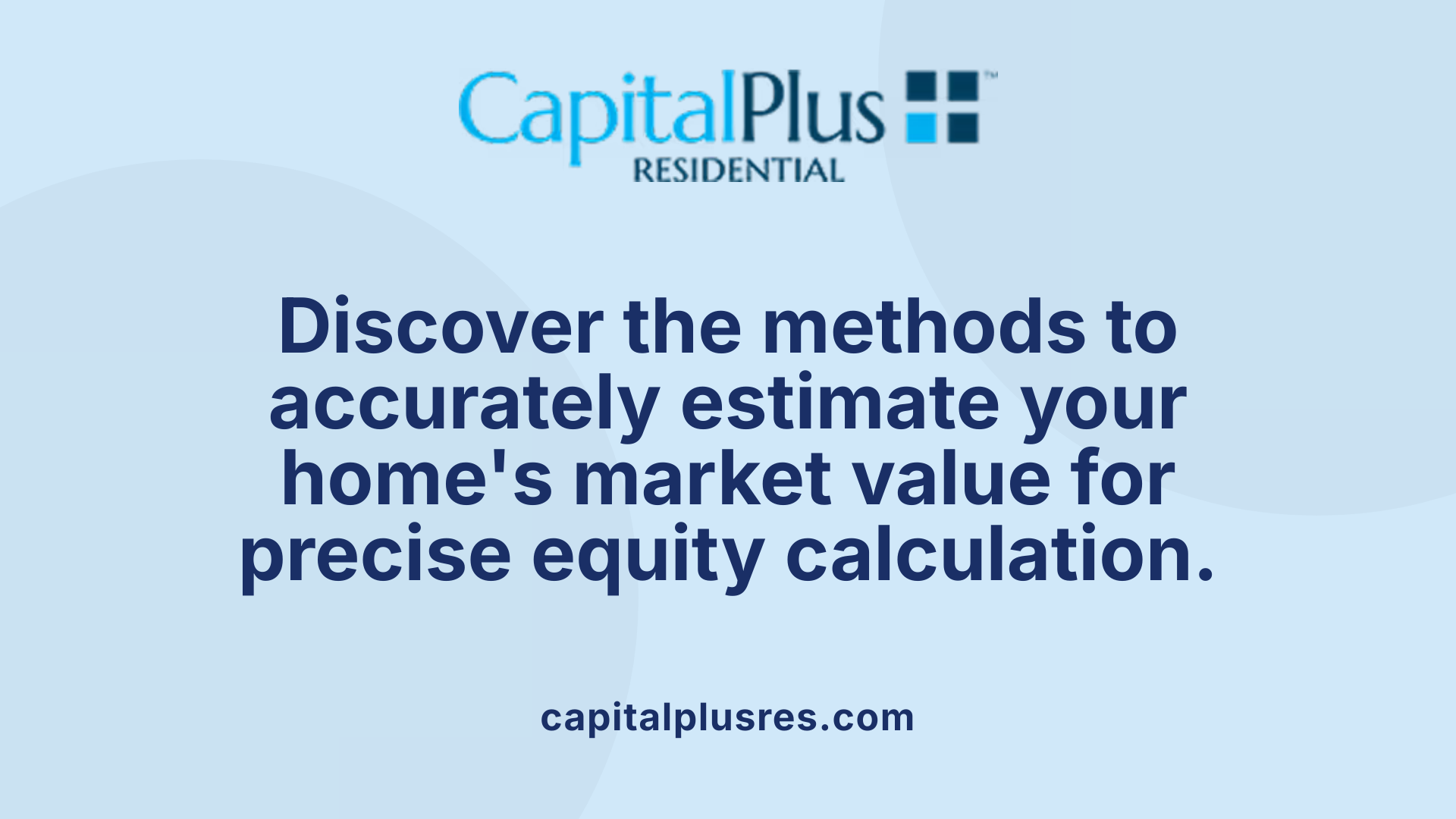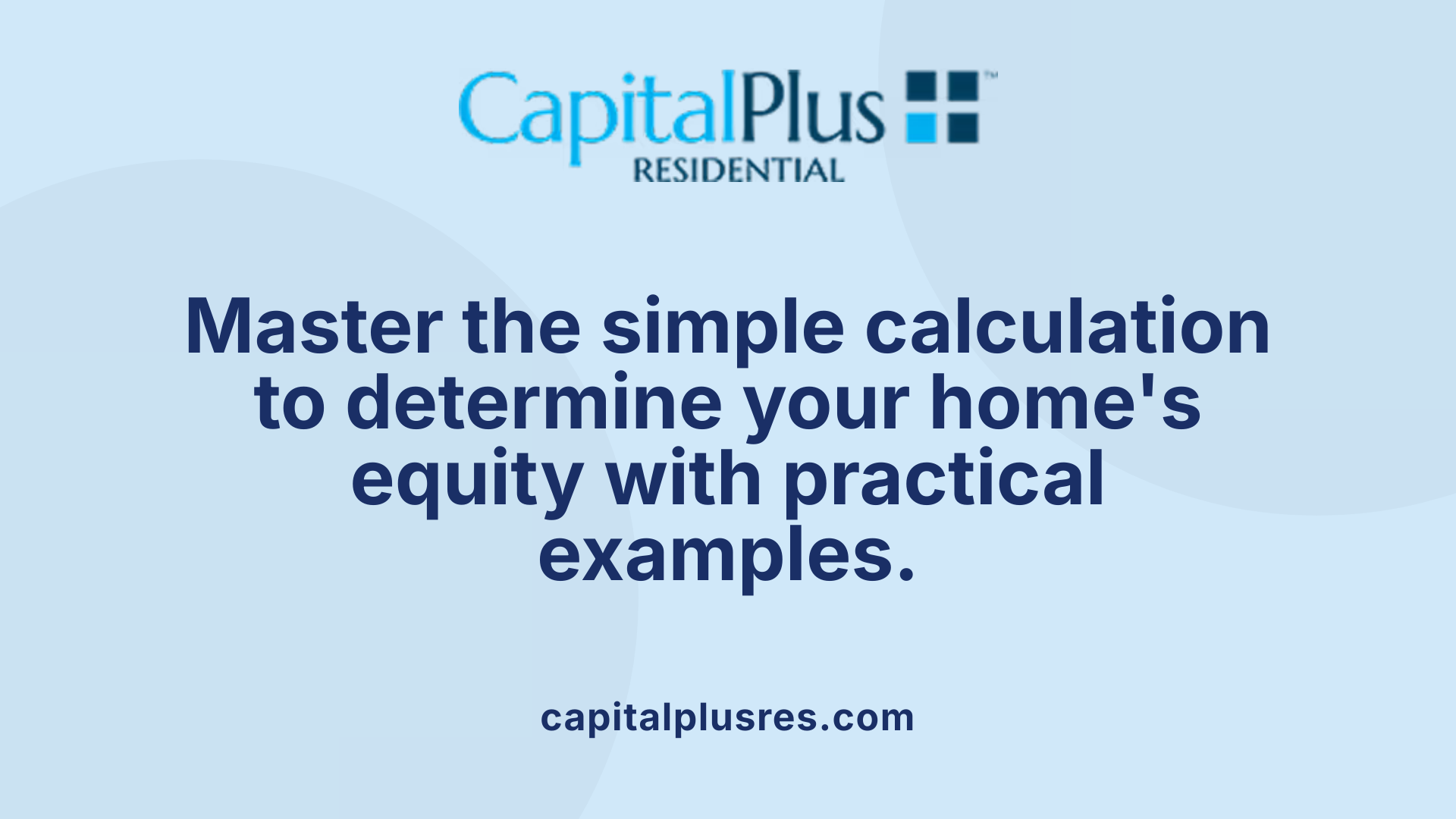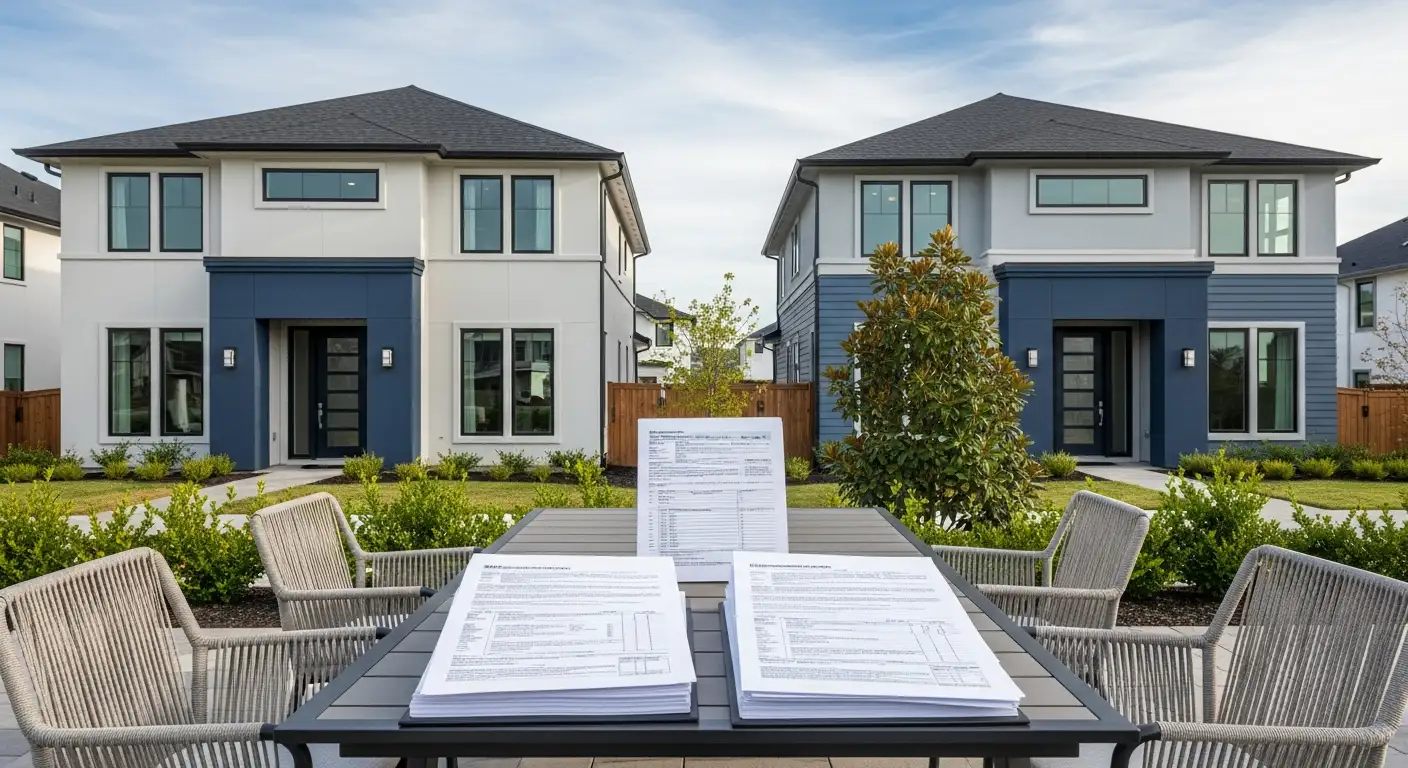Why Knowing Your Home Equity Matters
Understanding the equity in your home is crucial not only for informed borrowing decisions but also for effective financial planning. Home equity represents the portion of your property that you truly own, and calculating it accurately can open doors to borrowing opportunities and increase your financial flexibility. This article will walk you through the essential steps and concepts involved in determining your available home equity, helping you leverage your asset wisely.
Understanding Home Equity: The Basics

What is home equity and how is it calculated?
Home equity represents the portion of your home's value that you actually own outright. It is essentially the current market value of your home minus any debts secured by the property, such as your mortgage, home equity lines of credit (HELOCs), or liens. This figure reflects your stake in the home and can fluctuate over time.
How to calculate home equity
To calculate your home's equity, start with the latest appraised or estimated market value of your property. This value can be determined through professional appraisals, recent sales of comparable homes in your area, or online value estimators. From this number, subtract the total balance you owe on all loans secured by the home. The formula looks like this:
Home Equity = Current Market Value of Your Home – Outstanding Mortgage and Other Home-Secured Debt Balances
Be sure to include all relevant loans, such as first mortgages, second mortgages, and HELOCs, for the most accurate measurement.
Why market value and mortgage balance matter
The market value of your home directly impacts the amount of equity you hold. If home prices increase, your equity grows; if prices fall, your equity shrinks. Conversely, as you make mortgage payments, the outstanding loan balance decreases, which increases your equity. Maintaining awareness of both these figures helps you understand your financial position and borrowing potential. Knowing your home equity also aids in planning for refinancing, home equity loans, or HELOCs.
Determining Your Home’s Current Market Value

Methods to estimate home value
Homeowners have several options to estimate the current market value of their property. One common method is using online home value estimators, which provide quick estimates based on recent sales data and public records. These tools are convenient and accessible but may lack precision due to varying data quality and market factors.
Role of professional appraisals versus online estimators
While online estimators offer useful preliminary information, lenders typically require professional appraisals for an accurate and official valuation. Professional appraisers conduct thorough analyses that include inspecting the home, comparing it to similar recently sold properties, and accounting for current market conditions. This detailed evaluation ensures a reliable figure, which is crucial for loan approvals, refinancing, or home equity borrowing.
Why accurate valuation matters
Accurate home valuation plays a vital role in financial planning and borrowing decisions. It directly impacts the calculation of home equity, which is the difference between the market value of your home and the total amount owed on all secured debts like your mortgage. Having the correct market value helps you understand how much equity is available for borrowing and influences important ratios such as the loan-to-value (LTV) ratio that lenders use to assess risk and determine loan eligibility. An underestimated value might limit access to funds, while an overestimated value could lead to borrowing more than is prudent.
How do I determine the current market value of my home?
You can estimate your home's market value using online home value estimators, but lenders typically require professional appraisals, which consider recent sales of similar properties and current market conditions to provide an accurate valuation.
Calculating Outstanding Mortgage and Secured Debts

How to find total owed amounts
To accurately calculate your home equity, begin by determining the total amount you owe on all debts secured by your home. This includes your current mortgage balance, any home equity loans, Home Equity Lines of Credit (HELOCs), and any liens placed against the property.
You can find these amounts by reviewing your mortgage statement, loan documents, or recent billing statements from lenders. Combining all these figures will give you the total debt secured by your home.
Types of debts affecting equity
Home equity is affected not just by your primary mortgage but also by other secured debts such as HELOCs and second mortgages. Additionally, any liens—from unpaid taxes or construction work—also reduce your home equity because they are claims against your property.
Including mortgages, HELOCs, liens
Simply subtract the sum of your mortgage balance, HELOC balances, second mortgage amounts, and any liens from the current market value or appraised value of your home to arrive at your net home equity.
What debts must be subtracted from my home’s value to find equity?
You must subtract all debts secured against your home. This includes your primary mortgage balance, any home equity loans, HELOCs, and additional liens. These amounts are typically found on mortgage statements and loan documents.
Keeping an accurate total of these debts is essential for understanding your available equity, which influences your borrowing potential and financial decisions regarding your home.
Applying the Home Equity Formula

What formula should I use to calculate home equity?
To calculate your home's equity, use the straightforward formula:
Home Equity = Current Market Value of Your Home – Outstanding Mortgage Balance and Other Secured Debts
This means you start by determining the current market value, which can be found through professional appraisals or reliable online estimators. Then, subtract the total amount you owe on your mortgage and any additional liens or home equity lines of credit (HELOCs) secured by your property.
Examples of home equity calculations
For instance, if your home is appraised at $400,000 and you owe $250,000 on your mortgage and $25,000 on a HELOC, your home equity would be:
$400,000 – ($250,000 + $25,000) = $125,000
This $125,000 represents the portion of your home that you truly own outright.
If the market value increases to $450,000 and your debts remain the same, your equity grows to:
$450,000 – $275,000 = $175,000
Understanding this formula helps you gauge how much you could potentially borrow against your home or how much value you have built over time. Remember, lenders often consider your loan-to-value (LTV) and combined loan-to-value (CLTV) ratios when determining borrowing limits, which directly relate to your calculated equity.
The Role of Loan-to-Value (LTV) and Combined Loan-to-Value (CLTV) Ratios

What are LTV and CLTV ratios and how do they affect borrowing?
The Loan-to-Value (LTV) ratio is a financial metric used by lenders to assess the risk involved in lending against a property. It is calculated by dividing the current outstanding loan balance by the home's appraised market value and then converting that figure into a percentage. For example, if a home is worth $300,000 and the current mortgage balance is $210,000, the LTV ratio would be 70%.
The Combined Loan-to-Value (CLTV) ratio extends this concept by including all secured loans against the home, such as first mortgages, home equity loans, and home equity lines of credit (HELOCs). Essentially, CLTV is the total amount owed divided by the home's appraised value. This ratio gives a broader picture of the overall mortgage burden on the property.
How CLTV differs and why it matters
While LTV considers a single loan (usually the primary mortgage), CLTV takes into account all debts secured by the home. This broader perspective is crucial for lenders because it reflects the total risk associated with the property. For instance, if a homeowner has a primary mortgage at 70% LTV and a second mortgage or HELOC amounting to 10% of the property value, the CLTV would be 80%.
Maintaining a CLTV below about 85% is important because lenders typically set this as a limit for certain types of borrowing, helping ensure the borrower has enough equity cushion and reducing the lender's exposure to risk.
Impact of these ratios on borrowing limits
LTV and CLTV ratios directly affect how much you can borrow against your home’s equity and the terms you'll receive. Generally, lenders prefer an LTV of 80% or less, equating to borrowing only up to 80% of the home's value.
When combined loans are considered, the CLTV cap influences the total borrowing capacity. For example, if your home is valued at $400,000 and lenders allow a maximum CLTV of 85%, the total outstanding loans should not exceed $340,000. Subtracting existing mortgage debt determines the additional borrowing potential.
Lower LTV and CLTV ratios usually translate into better loan terms, including lower interest rates and reduced fees, because they represent less risk for lenders. Conversely, higher ratios may limit borrowing options or increase costs.
Understanding these ratios empowers homeowners to manage their finances and home equity borrowing effectively, ensuring they stay within lender guidelines and avoid overleveraging their property.
Determining Borrowing Capacity from Home Equity
Typical borrowing limits based on LTV and CLTV
Lenders usually allow homeowners to borrow up to 80% to 85% of their home's appraised value when factoring in all outstanding loans. The Loan-to-Value (LTV) ratio—which is the mortgage balance divided by the home's current market value—typically needs to stay at or below 80%. In addition, the Combined Loan-to-Value (CLTV) ratio accounts for all secured loans on the property, such as first mortgages, second mortgages, and home equity lines of credit (HELOCs). Maintaining a CLTV below about 85% is commonly required for most borrowing options.
How to calculate maximum borrowable amount
To estimate the maximum amount you can borrow against your home equity, start with your home's current appraised value. Multiply this value by the maximum allowable CLTV set by lenders (usually around 85%). Then subtract your outstanding mortgage balance and any other home-secured debts. This formula looks like this:
Maximum Borrowable Amount = (Home Value × Max CLTV) – Current Mortgage Balance
For example, if your home is worth $300,000 and the lender allows an 85% CLTV, the maximum combined loan amount is $255,000. If you owe $200,000 on your mortgage, you might borrow up to $55,000 through a home equity loan or HELOC.
Influence of lender policies
Individual lender policies and your credit profile influence borrowing limits. Some lenders may offer slightly higher or lower CLTV thresholds. They also consider credit scores, debt-to-income ratios, and loan purpose when approving amounts. Transaction costs like closing fees can reduce the net usable equity. Therefore, while 80-85% is a common guideline, actual borrowing capacity varies.
Understanding your home equity and these limits helps in financial planning for home equity loans, HELOCs, and refinancing options. Regularly updating the home's appraised value and mortgage balances ensures accurate calculations for borrowing capacity.
How much of my home equity can I borrow?
Lenders generally allow borrowing up to 80-85% of the home's value when considering existing debts. The borrowable amount can be calculated using this formula: (Home Value × Maximum CLTV) – Current Mortgage Balance. However, specific borrowing limits depend on lender policies and your creditworthiness.
Increasing Home Equity: Strategies and Benefits
How can I increase my home equity over time?
Increasing your home equity can be a valuable way to boost your financial flexibility. One straightforward method is making extra mortgage payments. By reducing the principal loan balance faster, you increase your equity, which is the difference between your home's market value and what you owe.
Strategic home improvements also play a crucial role. Renovations and regular maintenance can enhance your home's market value, thereby raising your equity. Focus on upgrades that provide strong returns, such as kitchen or bathroom remodels and improving curb appeal.
Market appreciation further influences home equity. As home prices rise in your area, the value of your property typically increases, naturally boosting your equity without additional investment.
In summary, increasing home equity involves a combination of reducing debts secured by your home, improving property value through key renovations, and benefiting from positive market trends. These strategies help maximize the amount you could borrow against your home or simply build wealth over time.
Risks and Considerations in Using Home Equity
What are the risks of borrowing against home equity?
Borrowing against your home equity can provide financial flexibility but comes with notable risks that homeowners need to consider carefully. One primary risk involves interest rate fluctuations. Many home equity loans and lines of credit (HELOCs) have variable interest rates, meaning your monthly payments could increase if rates rise, potentially straining your budget.
Another serious risk is the possibility of foreclosure. Since home equity loans are secured by your property, failure to keep up with payments could lead to losing your home. This risk emphasizes the importance of understanding your financial capacity before borrowing.
Prudent borrowing is essential when using home equity. It’s important not to overextend by taking out more than you can comfortably repay. Careful assessment of your debt, income stability, and future repayment ability should guide decisions involving home equity. Keep in mind that additional borrowing can increase your overall debt load and monthly obligations.
Overall, while accessing home equity can support home improvements, debt consolidation, or emergency expenses, homeowners should weigh these benefits against potential downsides. Maintaining responsible borrowing habits and regularly reviewing your loan terms can help protect your financial wellbeing and safeguard your home.
Common Mistakes to Avoid When Calculating Home Equity
What mistakes should I avoid when calculating my home equity?
Calculating home equity might seem straightforward, but several common errors can lead to inaccurate results.
Using outdated home values is a frequent mistake. Home values fluctuate due to market conditions, so relying on old estimates or online tools without recent appraisals can misrepresent your actual equity.
Ignoring all secured debts is another pitfall. Home equity isn’t just your mortgage balance subtracted from the home’s value; you must also include other debts secured by your home, such as home equity lines of credit (HELOCs) or second liens. Forgetting these loans overstates your equity.
Overlooking transaction costs such as closing fees or loan origination expenses reduces your usable equity. These costs should be factored in when planning to borrow against your home to avoid surprises.
Avoiding these mistakes ensures you have a realistic understanding of your financial position. Always use up-to-date appraised values, include all loans tied to your property, and consider related fees for an accurate equity calculation.
Regularly Reassessing Your Home Equity for Financial Planning
Why to recalculate home equity periodically
Home equity represents the difference between your home's current market value and the total amount owed on all mortgages secured by the property. Because home values and mortgage balances fluctuate over time, recalculating your home equity regularly is crucial. Accurate, up-to-date equity calculations provide a clear picture of your financial standing and can uncover new borrowing opportunities.
How often should I recalculate my home equity?
It is advised to recalculate home equity periodically, especially when considering refinancing, applying for loans, or after significant market changes. This helps ensure you know the precise amount of equity available for borrowing or financial planning, avoiding decisions based on outdated information.
Impact of market fluctuations on your equity
Home values can rise or fall due to market conditions, directly impacting your equity. An increase in market value raises equity, enhancing your borrowing power. Conversely, a decrease reduces equity and can limit loan options or even put you at risk if the mortgage balance surpasses home value. Regular assessments help you stay informed of these changes.
Using equity calculations for refinancing and loans
Lenders rely on current home equity and loan-to-value (LTV) ratios when approving refinancing, home equity loans, HELOCs, or cash-out refinancing. A recalculated equity value reflects your current borrowing capacity and can help you secure better loan terms. Neglecting to update your equity estimate may lead to applying for amounts beyond what lenders permit.
By periodically recalculating your home equity, you maintain control over your financial strategy, monitor risks during market shifts, and ensure you maximize borrowing potential safely.
Making the Most of Your Home Equity
Calculating your home equity accurately is the first step toward unlocking financial opportunities, whether for refinancing, debt consolidation, or funding major expenses. By understanding the core concepts—including the importance of market value, mortgage balances, and LTV ratios—and staying aware of the risks and common pitfalls, homeowners can confidently leverage their property's value. Regularly reassessing your equity and maintaining healthy financial habits can maximize your borrowing power and provide greater financial flexibility.
References
Latest Blog


Get Pre-Approved Today
Start your secure online application now so you can get pre-approved for a mortgage (and close on your dream home) quickly within 5 minutes.









